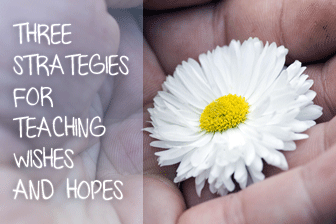
Teaching hopes and wishes to varied levels of ESL learners can be enjoyable and enlightening. This is something that can be introduced in a high beginner class and then expanded upon as their language skills increase.
It’s a great way to get them talking about aspirations, dreams and possibly even hidden desires. Here are some strategies for teaching wishes and hopes that you can revisit and revamp in many different ways for various levels.

HOWTO: Teaching Wishes and Hopes
-
1
What’s the Difference?
First off, what is the difference anyway? There is a difference in both structure and meaning. ‘I wish’ refers to lofty or unrealistic dreams. Most of the time when we use ‘I wish’, we want something that is impossible, or that doesn't seem likely. We may even feel sorry that things are not different. Some examples are:
- I wish I had a million dollars.
- I wish I could fly to the moon.
- I wish my sister could be here now.
Hopes are a bit different. When we use ‘I hope’, we want it to happen, but are uncertain that it will. It is also often out of our control whether it happens or not. Some examples are:
- I hope Jane gets better.
- I hope it stops raining soon.
- I hope my son comes back from the war.
-
2
The Structures
Ask the students what they notice about the structural differences from the examples above. If you are starting this lesson with a lower level, you could opt to only focus on the simpler tenses. Discuss it with them and provide the following points as you go:
Wish
Structure Example Subject + Wish + Subject + Past Tense I wish I was better-looking. I wish I spoke Italian. I wish I had better news Subject + Wish (that) + Subject + Past Perfect I wish I had gone with John. I wish I had studied harder for the test. Hope
Structure Example Hope is commonly used with –ing + for + object I'm hoping for some good weather today. Hope + an infinitive (a bit formal) I hope to study in Europe next year. Hope + that-clause I hope that there is cake at the party. -
3
Practice
There are a lot of different ways you could choose to practice both wishes and hopes. You could do a “Find Someone Who” activity in which the students need to mingle and ask questions to each other. Examples of the topics could be things like: Find someone who … wishes he/she was in Hawaii, hopes to learn how to ski, wishes he/she was more beautiful, wishes that they could win a gold medal, etc. Another way to practice wishes and hopes is to do some creative fill-in-the-blanks exercises combined with discussion. The students could complete any number of statements like:
I wish I was more _________.
I hope I can _________________ this year.
I wish that my family ___________.These are great to do in pairs or even as a group to get students talking. Be sure to include all the variable structures shown above and give them opportunities to practice using them as naturally as possible!
When approaching hopes and wishes, you will want to keep the class focused on the positive.
Sometimes this kind of activity can lead to students getting emotional or over-analyzing their situations. Be sure to present these activities with sensitivity and be prepared to deal with both the entertaining pieces as well as the more emotional.
P.S. If you enjoyed this article, please help spread it by clicking one of those sharing buttons below. And if you are interested in more, you should follow our Facebook page where we share more about creative, non-boring ways to teach English.







